Broncos extend contract of young forward Keenan Palasia
In recruitment news, the Broncos have announced the re-signing of young forward Keenan Palasia (22) on a two year deal until the end of 2021.
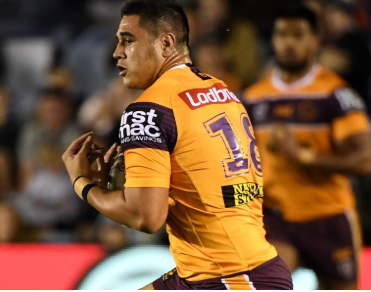
The club’s decision to re-sign the young Queenslander is very questionable given the player has been beset by repeated knee injuries, and when on the field in 2019, his defensive performances were repeatedly poor, with the player missing on average 3 tackle per match last season.
Contrasting Palasia’s on field performances last season with that of his Broncos team mates, and the youngster finished last season as the Broncos’ 16th most productive forward.
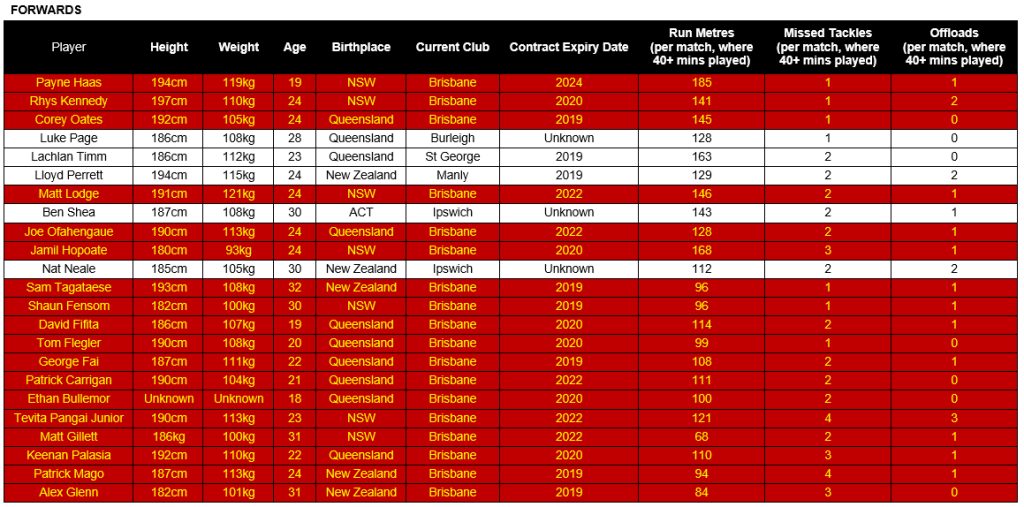
With the departure of Gillett, Tagataese, Fensom, abd Mago the Broncos had an opportunity to also release Palasia and use the salary cap space to recruit a more productive forward, or at least retain the released Fai.
Instead the Broncos again demonstrated their lack of ruthlessness in recruitment and re-signed Palasia, which is another poor use of the Broncos’ cap space.
Freddie08
Tragedy for Gillett as injury forces early retirement, but it is a blessing in disguise for the Broncos
Broncos second-rower Matt Gillett has announced his retirement from the game due to injury.
As a player who emerged from the Broncos’ youth academy, it was sad to see Gillett’s career come to an end in such a fashion. That said, given Gillett’s dire on field performances in recent seasons, and the substantial salary cap space his wage was consuming, his premature departure is somewhat of blessing in disguise for the club. While the New South Wales born second-rower could come up with a big hit now and then, it didn’t compensate for his consistent lack of run metres as an 80 minute player (a shocking average of just 67 metres per match in 2019).

2019 performance data – forwards
To be blunt, Gillett’s re-signing 12 months ago seemed like a waste of precious cap space by the Broncos. His premature departure while sad, is a positive thing for the future of the club.
Freddie08
Blow to Broncos’ 2019 prospects as Tagataese and Fensom retire
In a blow to the Broncos’ 2019 prospects, forward options Sam Tagataese and Shaun Fensom have announced their retirement from the game.


While neither player was given opportunities in the senior side in 2019, both players produced 96 run metres per game last season for Souths, as well as recording one offload and only one missed tackle per match.
While the Broncos have evidently committed to investing in the likes of Fifita, Flegler and Carrigan, all three players were out performed last year by the retiring duo, highlighting the club’s lack of focus on cultivating a high performance culture.

2019 productivity data – forwards
In light of that, Tagataese and Fensom’s departure is another disappointing moment for the Broncos’ recruitment and retention team.
While obviously it’s the players’ decision to conclude their playing career, one can’t help but feel both players would have continued their professional footballing careers at the club, had their on field performances been rewarded with more opportunities in the senior side.
While the Broncos have fortunately secured fellow forwards Haas, Kennedy, Oates, Lodge, Ofahegaue, and Hopoate for the 2020 season, as well as the likes Fifita and Flegler, it will be interesting to see if the Broncos pursue the likes of Luke Page, Lachlan Timm, Lloyd Perrett, Ben Shea or Nat Neale, given the superior on field performances in 2019 of those potential recruits to that of at least Fifita and Flegler.
Freddie08
Boost for Broncos as club announced Oates resigning
In a huge boost to the Broncos’ future premiership prospects, the club have announced the re-signing of outside back/forward Corey Oates (25) on a three year deal.

Oates’ resigning is a coup for the Broncos, with the young Queenslander finishing the 2019 season as the club’s third most productive forward, and second most productive centre and wing option and fullback option.

2019 productivity data – forwards
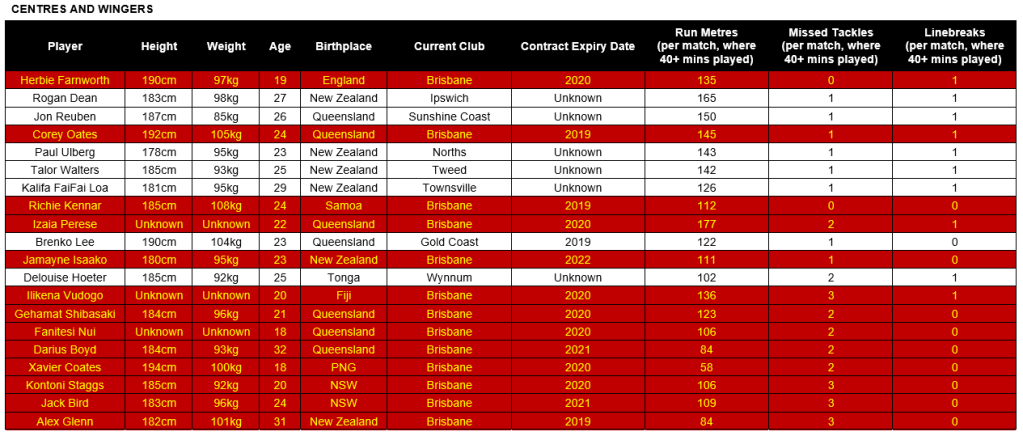
2019 productivity data – centres and wingers
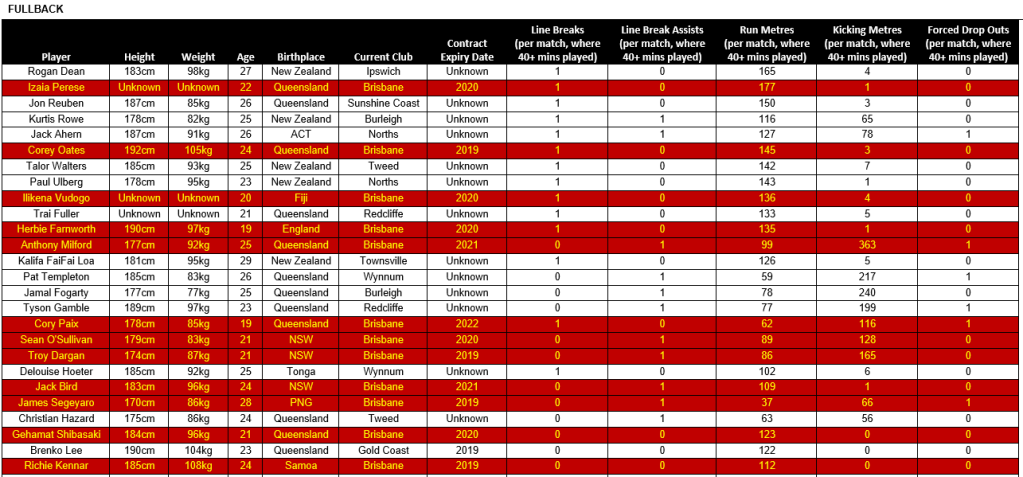
2019 productivity data – fullback
While it is unfortunate the second and third years of Oates’ contract are options for the player, with consistently unproductive players such as Bird, Boyd, McCullough, utilising substantial salary cap space and tied to multi-year deals at the club, the structure of the three year deal for Oates was evidently influenced by the Broncos’ salary cap constraints.
Nevertheless, the retention of Oates is great news for the Broncos’ future premiership prospects.
Freddie08
Season 2020: Which players should the Broncos retain, re-sign, move on and recruit
With the Broncos’ 2019 NRL campaign in the books, and the off season now upon the club, it’s an opportune time to examine the on-field production of each player in the senior squad, and the player market, in order to identify:
- which players the Broncos should retain/re-sign;
- which players the Broncos should seek to move on; and
- which players the Broncos should seek to recruit during the off season, based on their comparative on-field productivity.
Methodology
In assessing the on-field production and the comparative ranking of each player which comprise the Broncos’ senior squad, each player from that squad has been allocated into one of four positional categories (with some players considered in multiple positional categories due to their notional versatility).
Those four positional categories consist of:
- forwards;
- centres and wingers;
- halves and hooker; and
- fullback.
Once categorised, each player’s output in defined key performance indicators (KPIs) for their respective positional category has then been considered, using data sourced from the NRL and QRL.
Different weightings were then assigned to the KPI data considered for each positional group based on the assumption that the cornerstone of the Broncos’ tactical approach is as follows:
- To have minimal missed tackles (=<2 missed tackles per player per game) in all positional categories.
- To generate 100+ run metres and multiple offloads per game from each player in the forward positional group (to create second phase play for the halves, hooker and/or fullback to individually break the opposition’s defensive line or create line break opportunities for the centre and winger positional group).
- To generate 100+ run metres and multiple line breaks per game from each player within the centre and wing positional group.
- To generate 100+ kicking metres and multiple line breaks, line break assists, and forced drop outs per game from each player in the halves and hooker and fullback positional groups.
Once the relative on field productivity of the Broncos’ current senior squad was assessed, the comparative KPI data of non New South Wales born players, competing in the following leagues, was then reviewed:
- Intrust Super Cup; and
- NRL.
When considering players competing in the aforementioned leagues, only non New South Wales born players from the aforementioned competitions who are not contracted to an NRL club for 2020 season were considered. This was designed to restore the cultural identity of the Broncos and provide a realistic picture of the player market available to the Broncos.
The KPI data of the reviewed players was then contrasted against the KPI data of the players who currently comprise the Broncos’ senior squad, to identify prospective recruitment targets.
Player assessment and rankings

Starting with the forward positional group, it was a relatively productive season from the Broncos’ forwards, with a number of the club’s younger forwards (Haas, Kennedy, Fifita, Carrigan, Fai, and Bullemor) along with seasoned players, Oates, Lodge, and Ofahengaue, proving to be highly productive in terms of run metres gained per 40 minute performance, and minimal missed tackles per game.
That said, the productivity level of all the Broncos’ forwards in terms of offloads per 40 minute performance was underwhelming (with the exception of Pangai Junior and Kennedy). As such, it was no surprise to see the Broncos’ halves, hooker and fullback options, consistently struggle, in the absence of regular second phase play, to individually break the opposition’s defensive line or create line break opportunities for the centre and winger positional group. It is a facet of the Broncos’ attack the forwards will need to substantially improve upon in season 2020.
While a number of the Broncos’ younger forwards showed plenty of promise in terms of their on-field productivity, and the likes of Hopoate, Tagataese, Fensom, and Flegler excelled in certain aspects but were underwhelming either defensively (Hopoate) or in terms of run metres (Tagataese, Fensom, and Flegler), Palasia, Pangai Junior, Mago, Glenn, and Gillett consistently delivered unacceptable performances. For Pangai Junior and Mago, their defensive efforts were unacceptable. Palasia was underwhelming defensively without excelling in terms of run metres. Gillett’s contribution in terms of run metres was terrible. While Glenn struggled both in terms of his defensive effort as well as his run metre contribution.
Given that, and there being a number of superior forward options in the player market which the Broncos could realistically pursue, it would be logical for the Broncos to:
- retain Haas, Kennedy, Lodge, Ofahengaue, Hopoate, Fifita, Flegler, and Bullemor (as a developmental player);
- re-sign Oates, Tagataese, and Fensom;
- recruit Perrett, Timm, Page, Shea, and Neale;
- not re-sign Glenn, Fai, Palasia, or Mago; and
- move on Gillett, Pangai Junior, and Carrigan.

In terms of the club’s contracted centre and winger options, there were a number of players who could legitimately lay claim to having a productive season in 2019. Those players who proved to be productive in terms of run metres gained per 40 minute performance, while also producing minimal missed tackles per game were Farnworth, Oates, Kennar, Perese, Issako, Shibasaki, and Nui.
That said, the productivity level of all the Broncos’ centre and winger options in terms of line breaks per 40 minute performance was underwhelming. While this could in part be attributed to the absence of regular second phase play resulting in the Broncos’ halves, hooker and fullback options, consistently struggling to create line break opportunities for the centre and winger positional group, it is a facet of the Broncos’ attack the centres and wingers will need to substantially improve upon in season 2020.
While a number of the Broncos’ centres and wingers showed plenty of promise in terms of their on field productivity, and Vudogo excelled in terms of run metres but was underwhelming defensively, Boyd, Coates, Staggs, Bird, and Glenn consistently delivered unacceptable performances. Staggs and Bird were underwhelming defensively without excelling in term of run metres. Coates’ contribution in terms of run metres was terrible. While Glenn and Boyd struggled both in terms of their defensive effort as well as their run metre contribution.
Given that, and there being a number of superior centre and winger options in the player market which the Broncos could realistically pursue, it would be logical for the Broncos to:
- retain Farnworth, Perese, Vudogo (the latter two as fullback options), and Nui (as a developmental player);
- re-sign Kennar;
- recruit Dean, Ulberg, Walters, Fai Fai Loa, and Reuben;
- not re-sign Glenn; and
- move on Isaako, Shibasaki, Boyd, Coates, Staggs, and Bird.
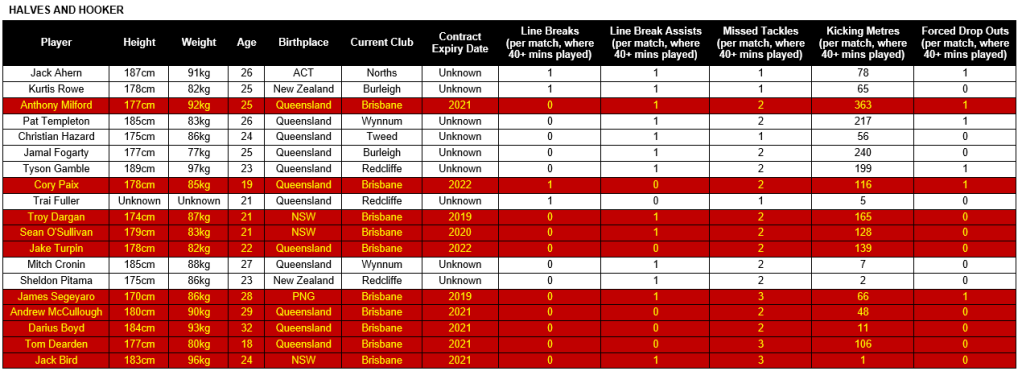
In the halves and hooker positional group, on field production was an issue all season, with only Paix averaging a line break per 40 minute performance. While Milford, Dargan (who has recently signed for the South Sydney Rabbitohs), Sullivan, Segeyaro and Bird all averaged a line break assist per match, only Milford and Segeyaro were consistently selected in the Broncos top 17. This was due to Seibold repeating the flawed team selection approach of his predecessor, Bennett, by selecting his weekly top 17 based upon players’ reputation as opposed to individual players’ on-field productivity.
Seibold, like Bennett, also failed to employ tactics which best complimented the skill set of the club’s halves and hooking options.
With the vast majority of the players in the positional group either inexperienced (e.g. Paix, Dargan, Sullivan, Turpin, and Dearden) or not possessing the creative passing game of traditional halves (e.g. Milford, McCullough, Segeyaro, and Boyd), the Broncos needed to generate a healthy number of offloads in each match to the create the second phase play and disorganisation in the opposition’s defence, and allow for simpler line break and line break assist opportunities for the club’s halves and hooking options.
As highlighted in the assessment of the Broncos’ forwards, the Broncos largely failed to generate the required offloads this season. As a consequence, the club’s halves and hooking options struggled to create. That said, the players who comprised the club’s halves and hooking options in 2019, did not help themselves as they failed to provide adequate support play for the club’s forwards.
That said, the likes of Milford, Paix, Dargan and O’Sullivan did demonstrate some, albeit underwhelming, offensive contribution per 40 minute performance, while also being productive kickers of the football and recording minimal missed tackles per game.
While those players were solid albeit slightly underwhelming, Turpin, Segeyaro, McCullough, Boyd, Dearden and Bird consistently delivered unacceptable performances. Segeyaro and Bird were underwhelming defensively without excelling in terms of their kicking or offensive productivity. Turpin was somewhat productive in his kicking game and was solid in defence, but underwhelmed in terms of his offensive production. Dearden was relatively productive in his kicking contribution, but was underwhelming defensively and offensively. While McCullough and Boyd struggled in terms of their defensive effort as well as their offensive and kicking contribution.
Given that, and there being a number of superior halves and hooking options in the player market which the Broncos could realistically pursue, it would be logical for the Broncos to:
- retain Milford;
- recruit Ahern, Rowe, Templeton, Fogarty, and Fuller (as a development player);
- not re-sign Dargan or Segeyaro; and
- move on Paix, O’Sullivan, Turpin, McCullough, Boyd, Dearden, and Bird.


Regarding the club’s contracted fullback options, there is no player who could legitimately lay claim to having a complete performance record, in terms of regular line breaks, line break assists, run metres, kicking metres and forced drop outs.
That said, Perese, Oates, Vudogo and Farnworth were all productive in terms of run metres, and each player averaged at least one line break per 40 minute performance.
While Milford fell just short of 100 run metres per game and failed to average a line break per match, he did manage to create at least one line break assist per 40 minute performance and kicked an impressive 363 metres per match, as well as averaging at least one forced drop out per game.
Outside of those four players, the remaining eligible players in the Broncos’ fullback positional category underwhelmed, with Dearden, Turpin, Boyd, Glenn, McCullough and Coates particularly poor.
Given that, and there being a number of superior fullback options in the player market which it is proposed that Broncos pursue to fill the centre and winger positional category, it would be logical for the Broncos to:
- retain Milford (but as a half or hooker), Oates (as a forward), Farnworth (as a centre or winger), Nui (as a development centre or winger), and Perese and Vudogo (as fullback options);
- re-sign Kennar (as a centre or winger);
- recruit Ahern, Rowe, Templeton, and Fogarty (as halves or hookers), Fuller (as a development half or hooker), Dean, Ulberg, Walters, Fai Fai Loa, and Reuben (as centres or wingers);
- not re-sign Glenn, Dargan or Segeyaro; and
- move on Paix, O’Sullivan, Turpin, McCullough, Boyd, Dearden, Bird, Isaako, Shibasaki, Coates, and Staggs.
Proposed Player Movement
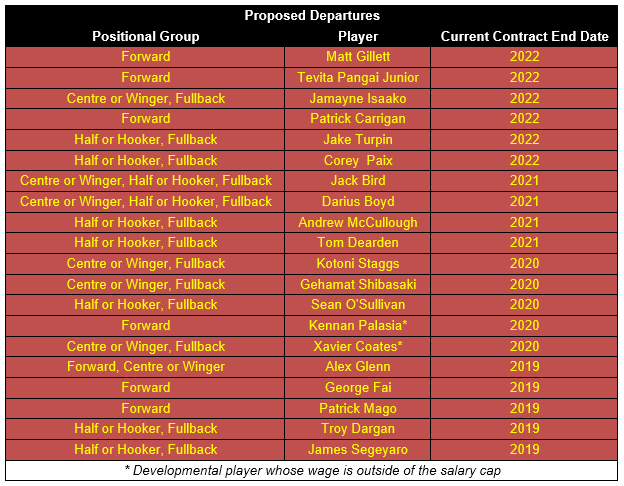
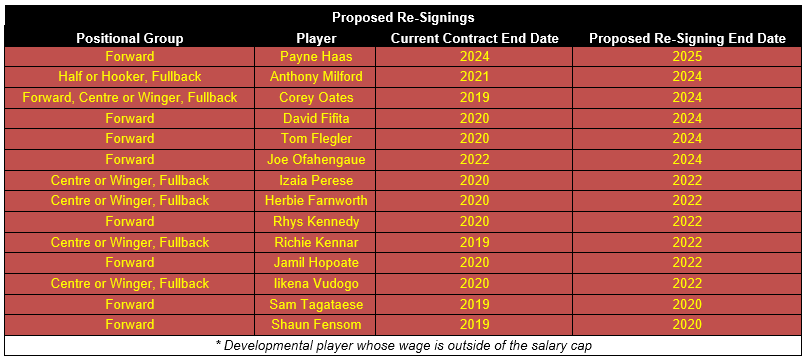

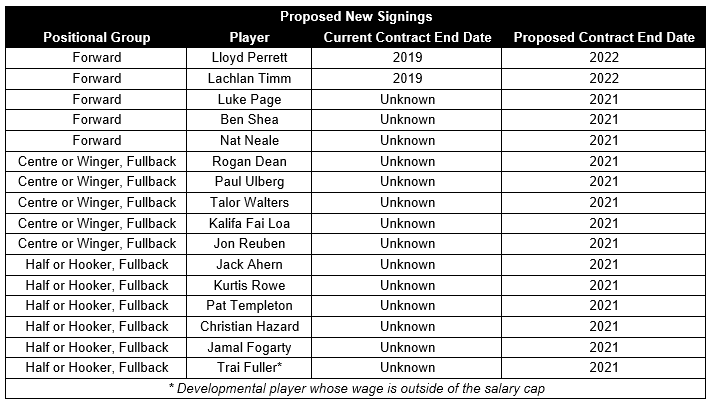
Line Up, Reserves and Development Players
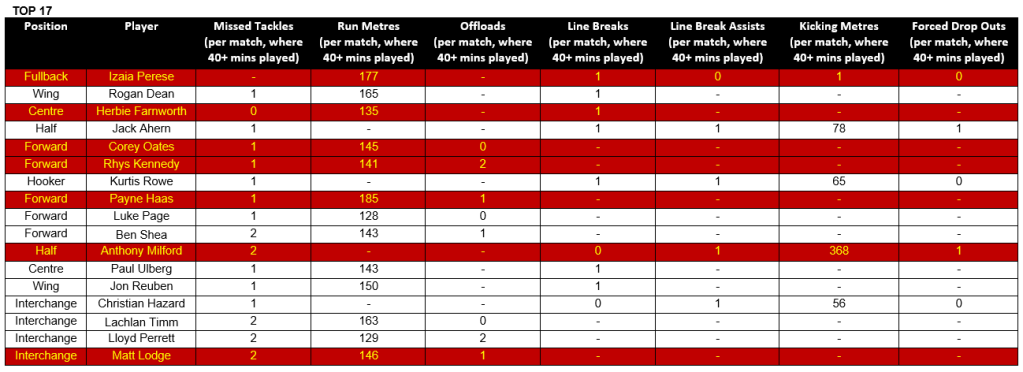



Freddie08
Broncos Analysis: Round 25 Player Analysis and Week 1 Finals Team Selection
Following each round of the NRL Premiership and Intrust Super Cup, each contracted Broncos player’s season-to-date performance is analysed and ranked against their internal competition.
This analysis process initially categorises players into four positional categories (with some players considered in multiple positional categories due to their perceived versatility):
- forwards;
- centres and wingers;
- halves and hooker; and
- fullback.
Once categorised, each player’s output in defined key performance indicators (KPIs) for their respective positional category is then considered, using data sourced from the NRL and QRL.
Different weightings are then assigned to the KPI data considered for each positional group based on the assumption that the cornerstones of the Broncos’ tactical approach is as follows:
- To have minimal missed tackles (=<2 missed tackles per player per game) in all positional categories.
- To generate 100+ run metres and multiple offloads per game from each player in the forward positional group (to create second phase play for the halves, hooker and/or fullback to individually break the opposition’s defensive line or create line break opportunities for the centre and wing positional group).
- To generate 100+ run metres and multiple line breaks per game from each player within the centre and wing positional group.
- To generate 100+ kicking metres and multiple line breaks, line break assists, and forced drop outs per game from each player in the halves and hooker and fullback positional groups.
The findings provide an invaluable insight as to:
- how each player ranks against their internal competition within their positional category; and
- which 17 players make up the Broncos’ most productive team.
Internal player rankings
Following Round 25 of the NRL and Week 1 Finals of the Intrust Super Cup, the player rankings are as follows:
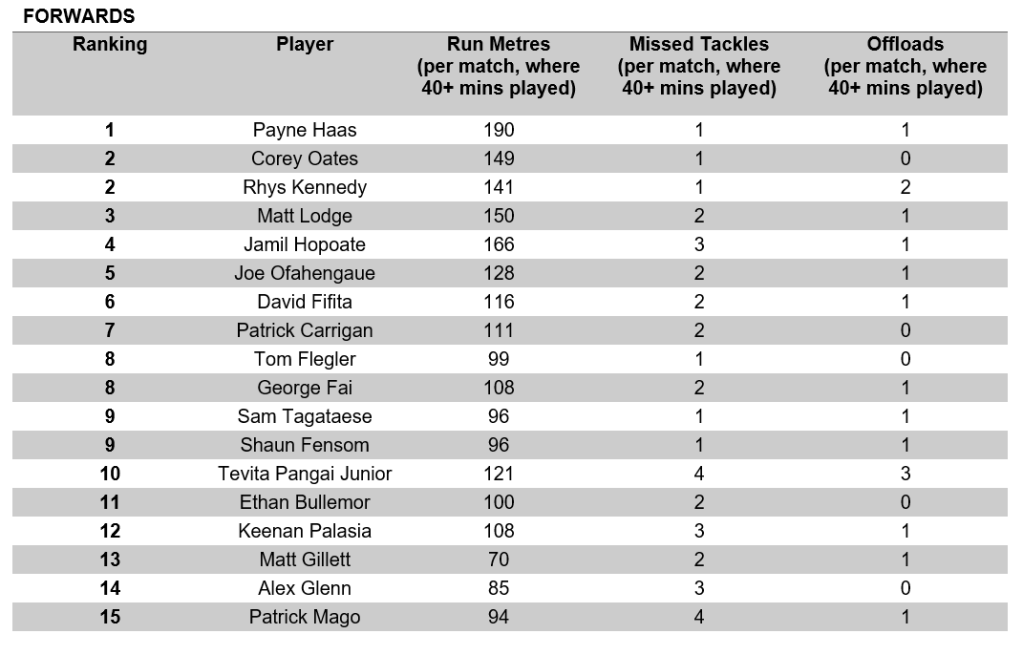
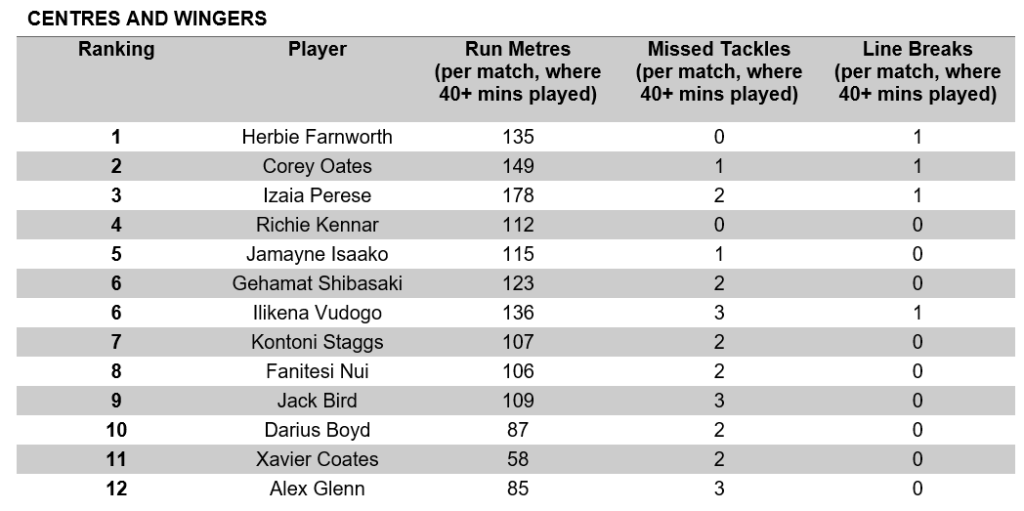

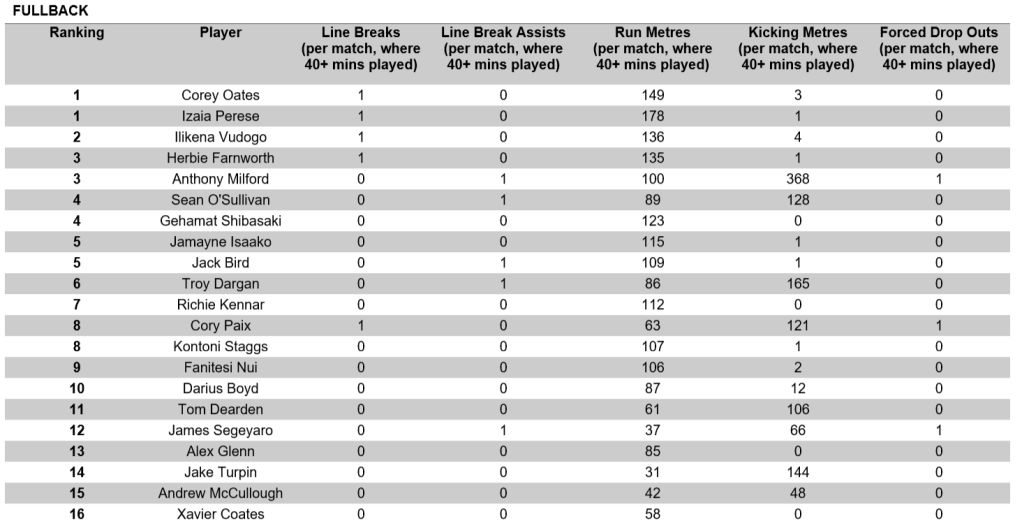
Week 1 Finals lineup
Based on the above analytical comparison, and with Kennar, Bird, Sullivan and Dearden injured, and Pangai Junior suspended, the 17 players which comprise the Broncos’ most productive team for their Week 1 Finals clash versus the Parramatta Eela would appear to be as follows (with the proposed interchange rotations also outlined below):
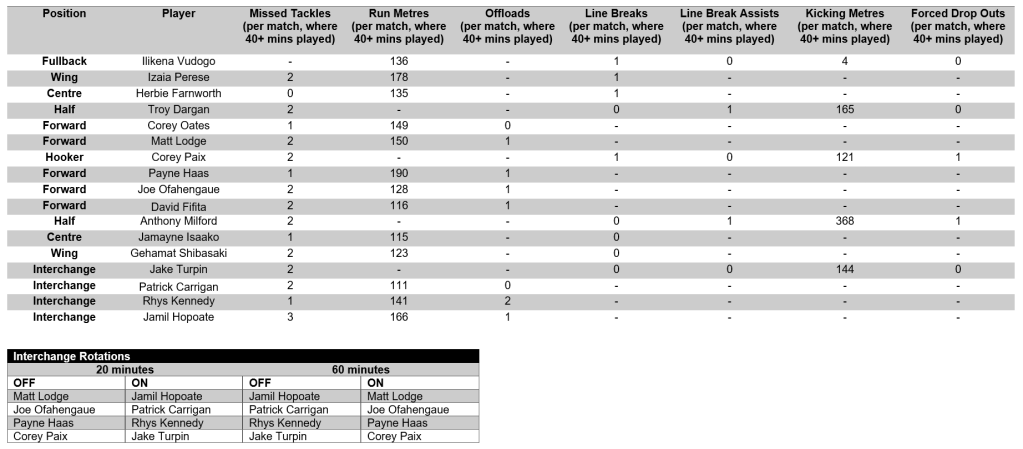
Freddie08
Broncos Analysis: Round 24 Player Analysis and Round 25 Team Selection
Following each round of the NRL Premiership and Intrust Super Cup, each contracted Broncos player’s season-to-date performance is analysed and ranked against their internal competition.
This analysis process initially categorises players into four positional categories (with some players considered in multiple positional categories due to their perceived versatility):
- forwards;
- centres and wingers;
- halves and hooker; and
- fullback.
Once categorised, each player’s output in defined key performance indicators (KPIs) for their respective positional category is then considered, using data sourced from the NRL and QRL.
Different weightings are then assigned to the KPI data considered for each positional group based on the assumption that the cornerstones of the Broncos’ tactical approach is as follows:
- To have minimal missed tackles (=<2 missed tackles per player per game) in all positional categories.
- To generate 100+ run metres and multiple offloads per game from each player in the forward positional group (to create second phase play for the halves, hooker and/or fullback to individually break the opposition’s defensive line or create line break opportunities for the centre and wing positional group).
- To generate 100+ run metres and multiple line breaks per game from each player within the centre and wing positional group.
- To generate 100+ kicking metres and multiple line breaks, line break assists, and forced drop outs per game from each player in the halves and hooker and fullback positional groups.
The findings provide an invaluable insight as to:
- how each player ranks against their internal competition within their positional category; and
- which 17 players make up the Broncos’ most productive team.
Internal player rankings
Following Round 24 of the NRL and Round 23 of the Intrust Super Cup, the player rankings are as follows:
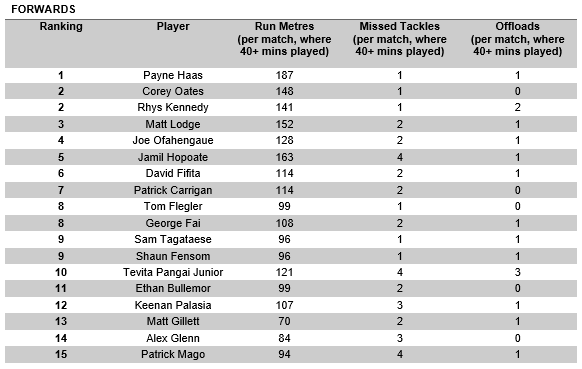


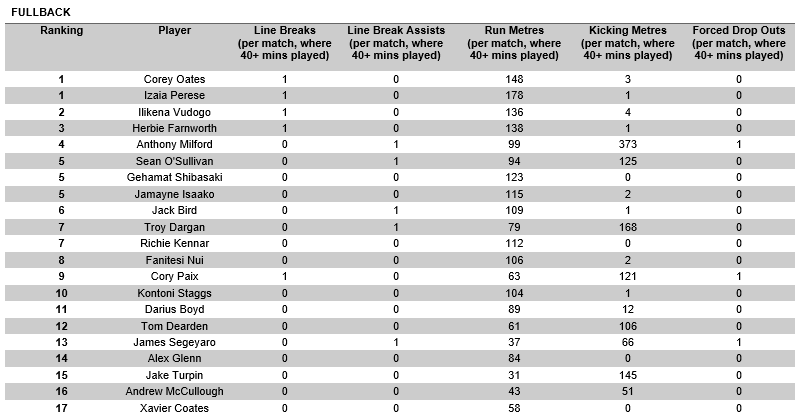
Round 25 lineup
Based on the above analytical comparison, and with Ofahengaue, Kennar, Bird, and Dearden injured, and Pangai Junior suspended, the 17 players which comprise the Broncos’ most productive team for their Round 25 clash versus the Canterbury Bulldogs would appear to be as follows (with the proposed interchange rotations also outlined below):

Freddie08
Broncos Analysis: Round 23 Player Analysis and Round 24 Team Selection
Following each round of the NRL Premiership and Intrust Super Cup, each contracted Broncos player’s season-to-date performance is analysed and ranked against their internal competition.
This analysis process initially categorises players into four positional categories (with some players considered in multiple positional categories due to their perceived versatility):
- forwards;
- centres and wingers;
- halves and hooker; and
- fullback.
Once categorised, each player’s output in defined key performance indicators (KPIs) for their respective positional category is then considered, using data sourced from the NRL and QRL.
Different weightings are then assigned to the KPI data considered for each positional group based on the assumption that the cornerstones of the Broncos’ tactical approach is as follows:
- To have minimal missed tackles (=<2 missed tackles per player per game) in all positional categories.
- To generate 100+ run metres and multiple offloads per game from each player in the forward positional group (to create second phase play for the halves, hooker and/or fullback to individually break the opposition’s defensive line or create line break opportunities for the centre and wing positional group).
- To generate 100+ run metres and multiple line breaks per game from each player within the centre and wing positional group.
- To generate 100+ kicking metres and multiple line breaks, line break assists, and forced drop outs per game from each player in the halves and hooker and fullback positional groups.
The findings provide an invaluable insight as to:
- how each player ranks against their internal competition within their positional category; and
- which 17 players make up the Broncos’ most productive team.
Internal player rankings
Following Round 23 of the NRL and Round 22 of the Intrust Super Cup, the player rankings are as follows:
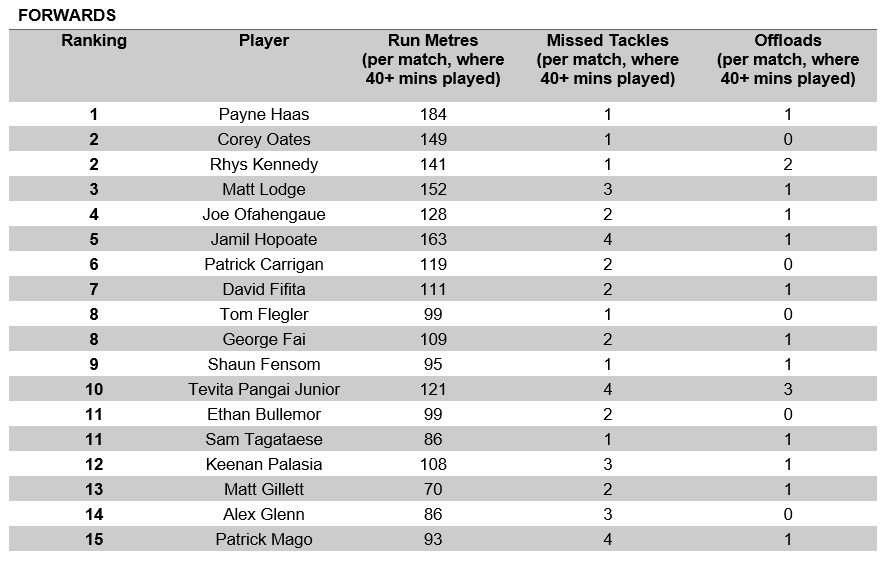
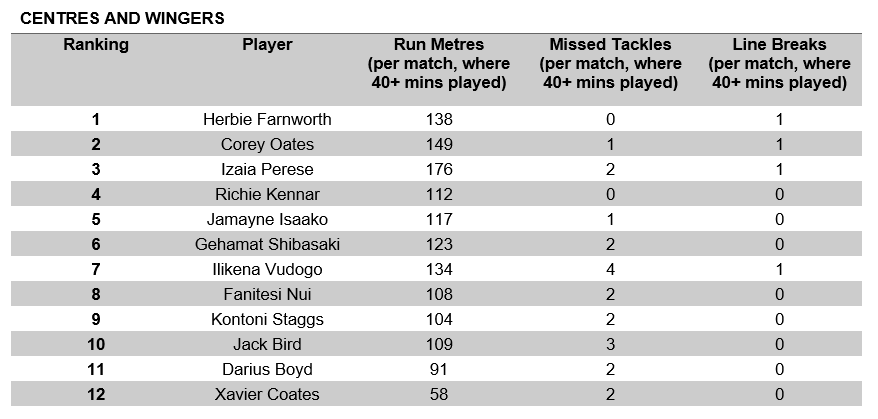

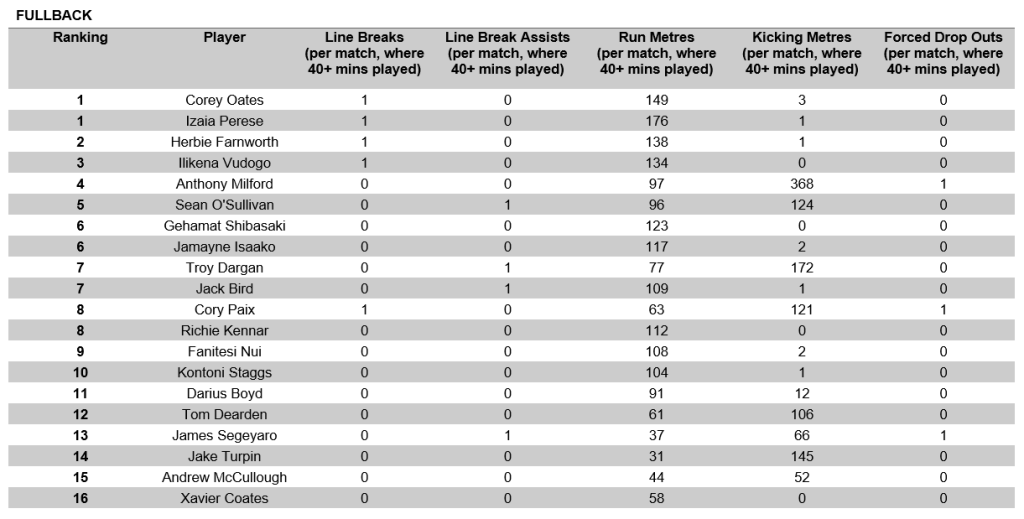
Round 24 lineup
Based on the above analytical comparison, and with Ofahengaue, Kennar, Bird, and Dearden injured, and Pangai Junior and Turpin suspended, the 17 players which comprise the Broncos’ most productive team for their Round 23 clash versus the Parramatta Eels would appear to be as follows (with the proposed interchange rotations also outlined below):
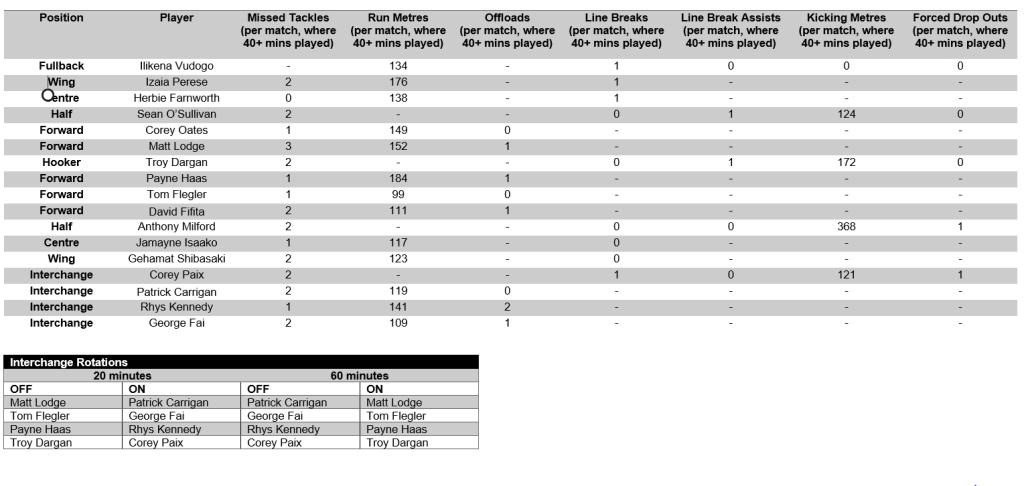
Freddie08
Broncos Analysis: Round 22 Player Analysis and Round 23 Team Selection
Following each round of the NRL Premiership and Intrust Super Cup, each contracted Broncos player’s season-to-date performance is analysed and ranked against their internal competition.
This analysis process initially categorises players into four positional categories (with some players considered in multiple positional categories due to their perceived versatility):
- forwards;
- centres and wingers;
- halves and hooker; and
- fullback.
Once categorised, each player’s output in defined key performance indicators (KPIs) for their respective positional category is then considered, using data sourced from the NRL and QRL.
Different weightings are then assigned to the KPI data considered for each positional group based on the assumption that the cornerstones of the Broncos’ tactical approach is as follows:
- To have minimal missed tackles (=<2 missed tackles per player per game) in all positional categories.
- To generate 100+ run metres and multiple offloads per game from each player in the forward positional group (to create second phase play for the halves, hooker and/or fullback to individually break the opposition’s defensive line or create line break opportunities for the centre and wing positional group).
- To generate 100+ run metres and multiple line breaks per game from each player within the centre and wing positional group.
- To generate 100+ kicking metres and multiple line breaks, line break assists, and forced drop outs per game from each player in the halves and hooker and fullback positional groups.
The findings provide an invaluable insight as to:
- how each player ranks against their internal competition within their positional category; and
- which 17 players make up the Broncos’ most productive team.
Internal player rankings
Following Round 22 of the NRL and Round 21 of the Intrust Super Cup, the player rankings are as follows:

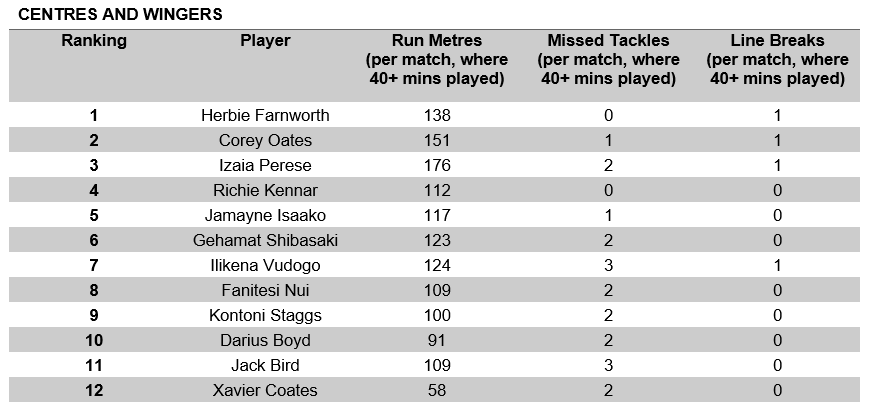

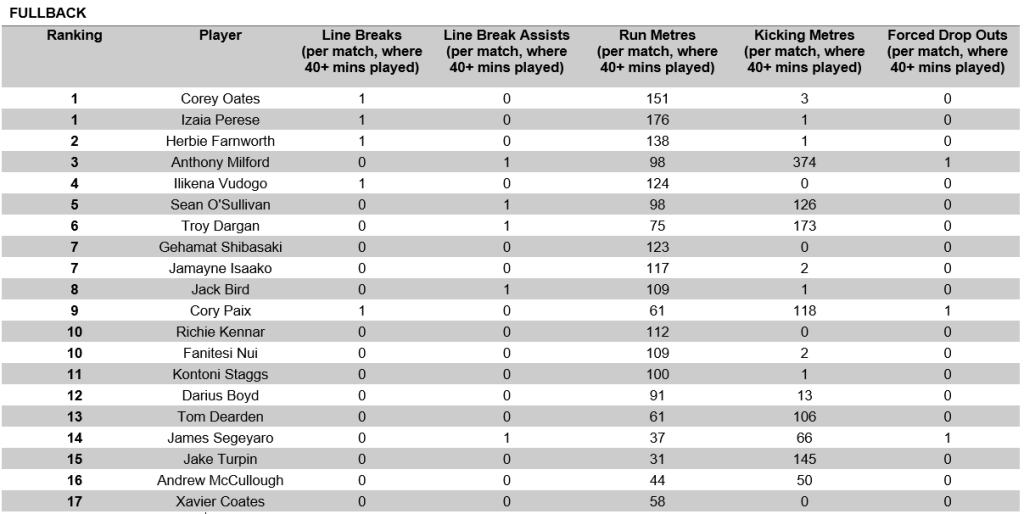
Round 23 lineup
Based on the above analytical comparison, and with Kennar, Bird, and Dearden injured, and Pangai Junior suspended, the 17 players which comprise the Broncos’ most productive team for their Round 22 clash versus the South Sydney Rabbitohs would appear to be as follows (with the proposed interchange rotations also outlined below):
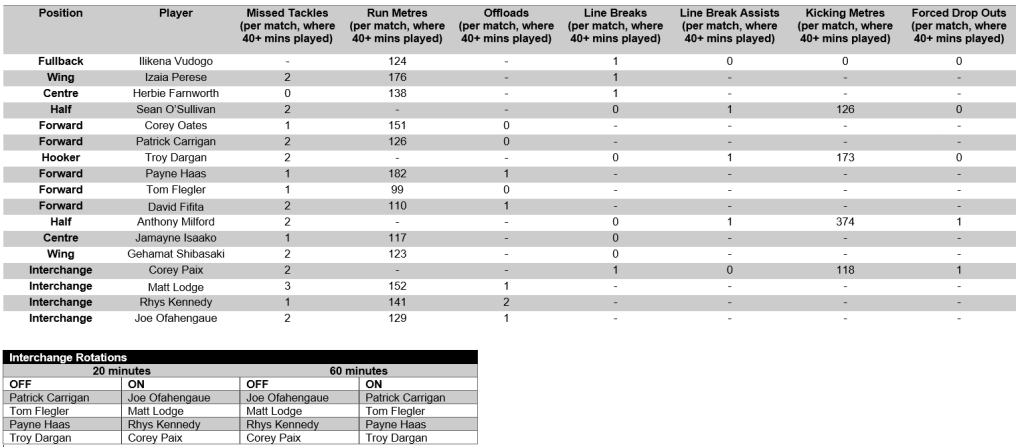
Freddie08
Poor recruitment decisions continue as Dargan to depart
In a blow to the Broncos’ future Premiership prospects, the Broncos have announced the departure of half, hooker and fullback option Troy Dargan to the South Sydney Rabbitohs, starting from season 2020.

Following round 21 of the NRL and round 20 of the Intrust Super Cup, Dargan was ranked as the club’s second most productive half and hooking option, averaging 1 line break assist, 2 missed tackle and 173 kicking metres per game.

The Broncos’ decision to not retain Dargan but to resign fellow halves and hooking options Jake Turpin to a three year deal, and offer Segeyaro a two year extension, despite both players producing inferior on field performances to the young New South Welshman, is baffling.
Obviously salary cap restraints mean the Broncos can’t retain all players. That said, the ongoing inferior on field performances this season from regular first graders Darius Boyd, Matt Gillett, Alex Glenn, Jack Bird and Andrew McCullough, as well as the likes of Shaun Fensom, Sam Tagataese and Patrick Mago, means the Broncos should have first sought to move on a number of those players, before contemplating not re-signing any of their 3 most productive halves and hookers, which includes Dargan.
Freddie08